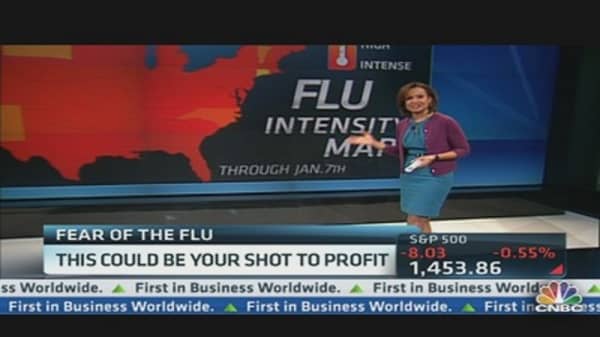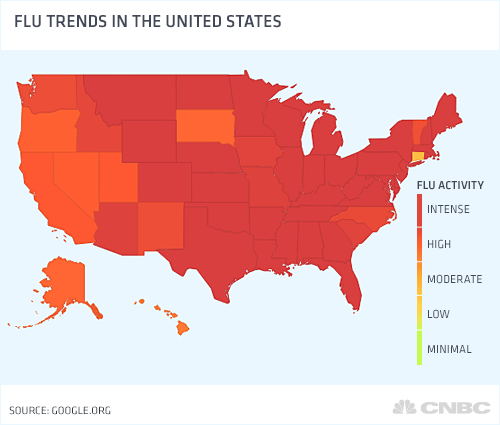It is shaping up to be the worst cold and flu season in about ten years, with more than 40 states reporting widespread influenza doctor visits and hospitalizations, according to the Centers for Disease Control.
"This year's strain appears to be similar to the one we saw back in 2003," said ISI Group health care analyst Ross Muken in an e-mail. "Flu hit early that season and was quite severe."
Analysts note searches related to the flu on Google's Flu-Tracker have risen sharply every week since the start of December, and are up about 200 percent from a year ago.
Flu Season Winners: Drug Stores, Tissue-Makers
The early start has already boosted flu shot demand. Walgreens reported earlier this month that it had administered 5.5 million flu shots by the end of December — up from 5.3 million in the same period a year earlier.
"Walgreen is a key provider of flu shots," said Muken, " so they are seeing a modestly outsized benefit."
Beyond flu shots, a strong cold and flu season could mean stronger sales for over the counter medication and other cold care items at Walgreens and its competitors, CVS Caremark and Rite Aid.
The six-month cold and flu season is a big driver of facial tissue sales. Kleenex-maker Kimberly-Clark and Procter & Gamble, which make Puffs, saw lower sales last year because of the mild season. They could see a boost in the current quarter.
Similarly, Helen of Troy CEO Gerald Rubin told analysts, after the personal care product maker's health care sales flagged last year, that a stronger cold season this year will bode well for sales. (Read More: Ryan: Is the Health Care Sector 'Healthy?')
"The cold season is very, very important to us," Rubin explained on the firm's 2012 fiscal fourth quarter conference call. "Not that we want people to get sick, but when the cold season does come, they do buy humidifiers and vaporizers and thermometers, which are a big part of our business."
Doctor Visits Impact Diagnostics, Hospitals, Insurers
The CDC reports outpatient visits and hospitalizations are up sharply with the early start of the flu season. That likely results in more testing for influenza, and higher overall medical costs. (Read More: GlaxoSmithKline Wins U.S. Approval for New Flu Vaccine)
"Higher flu incidence should be positive for several diagnostics companies," Leerink Swann analyst Jason Gurda wrote in a note to clients. Gurda noted micro-cap diagnostic firm Quidel, which gets about 10 percent of its revenue from flu-related testing, already pre-announced strong fourth quarter results. Alere, Hologic and Cepheid are among the other diagnostic firms he thinks could benefit.
Hospitals should see a modestly positive impact, Gurda said, noting Health Management Associates, Community Health and HCAhave more than 80-percent of their beds in the states with the worst flu levels. (Read More: 3 Top Health Care Plays: Barbara Ryan)
But all of the increased doctor visits, testing and hospitalizations will likely add up to higher medical costs for health insurers. In December, Centene lowered its guidance citing higher flu costs, among other expenditures. WellPoint and Aetna have both reaffirmed guidance in SEC filings this week.
Still, estimates are this year's flu season may not peak for another five weeks.
—By Bertha Coombs; Follow her on Twitter: @coombscnbc





